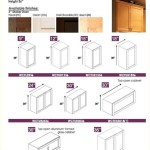Do I Have to Sand My Cabinets Before Staining?
When considering staining cabinets, one of the most common questions homeowners ask is whether or not they need to sand the surface beforehand. While the answer depends on several factors, sanding is generally recommended for optimal results.
Why Sanding Is Beneficial
Sanding provides several benefits that enhance the staining process and final appearance:
- Improved Adhesion: Sanding creates a rougher surface, allowing the stain to adhere better.
- Removal of Old Finish: Old paint, varnish, or polyurethane can prevent the stain from penetrating properly. Sanding removes these barriers.
- Smoothing Imperfections: Slight imperfections on the cabinet surface can be smoothed out through sanding, resulting in a more even finish.
- Enhanced Grain Exposure: For natural wood cabinets, sanding exposes more of the wood grain, highlighting its unique character.
When Sanding Is Not Necessary
In certain cases, sanding may not be necessary:
- Previously Stained Cabinets: If the cabinets were previously stained and the finish is still in good condition, sanding is not essential.
- Light Staining: If you plan on applying a light stain that does not require intense adhesion, sanding may not be necessary.
- Distressed or Rustic Look: If you desire a distressed or rustic look, sanding may not be necessary as it helps to preserve the natural wear and imperfections.
How to Sand Cabinets
If sanding is necessary, follow these steps:
- Remove all cabinet doors and hardware.
- Use a medium-grit sandpaper (120-150) for initial sanding.
- Sand in the direction of the wood grain to avoid cross-grain scratches.
- Switch to a finer-grit sandpaper (220-320) for finishing.
- Wipe down the sanded surfaces with a damp cloth to remove sanding dust.
Conclusion
While sanding cabinets before staining is generally recommended, it is not always necessary. Consider the factors outlined above to determine if sanding is required for your specific project. Proper preparation, including sanding when necessary, will ensure a professional and beautiful staining result that enhances the appearance of your cabinets.

Staining Your Wood Cabinets Darker Young House Love

How To Stain Oak Cabinetry Tutorial The Kim Six Fix

Staining Your Wood Cabinets Darker Young House Love

How To Clean Prep Wood Kitchen Cabinets Before Painting Do Dodson Designs

How To Paint Kitchen Cabinets Without Sanding Or Priming

Prep And Paint Cabinets Without Sanding

Yes Paint Over Stained Wood Without Sanding Porch Daydreamer

What You Need To Know Before Painting Cabinets The Palette Muse

Gel Stain Kitchen Cabinets Without Sanding Fast Easy Diy

How To Make Rustic Kitchen Cabinets By Refinishing Them The Best Stain Color Amanda Katherine
Related Posts








